La Roche M10c Achilles MkII 17pdr
This Surviving British Achilles 17pdr Tank Destroyer in the pretty village of La Roche-en-Ardenne took part in the 1944 WW2 Battle of the Bulge in the Belgium Ardennes. It has been preserved and can be found on the Avenue du Hadja where it meets the Rue du Chalet, in the western hills above La Roche-en-Ardenne, opposite Le Chalet Hotel.
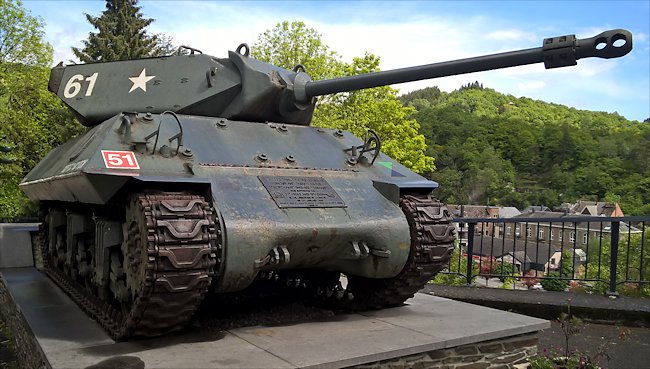
British M10c Achilles MkII 17pdr Tank Destroyer in the pretty village of La Roche-en-Ardenne
The M10c British Achilles fought from D-Day to Berlin
Just like D-Day itself the M10 Achilles Tank Destroyer was a joint enterprise between the Americans and the British. It was something of a ‘tankenstine’ monster. The main part of this TD was a normal American M10 Wolverine Tank Destroyer. If you look inside on the chassis you will find metal manufacture’s plate that say it is a M10 but the turret is a British design. They put a massive 17pdr gun on it and called it an Achilles. It is a self-propelled gun, built like a tank but with lighter armour.
The 17pdr gun was the biggest anti-tank gun the British built in 1944. It was also retro fitted to a Sherman tank that became known as the firefly. It was able to knock out German heavy armour. It was called a 17pdr because that was the weight of the huge shells it fired. It was originally designed as a normal field gun.
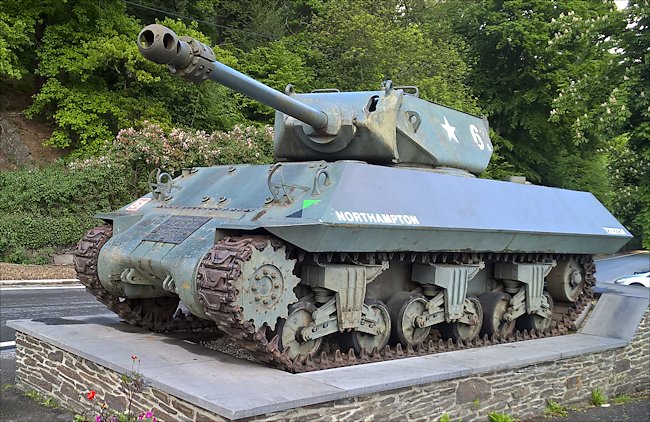
1st Northamptonshire Yeomanry British M10c Achilles MkII 17pdr Tank Destroyer
It performed so well in North Africa that the boffins back in Britain came up with the idea of putting it in the new M10s. The problem with the original M10 Wolverines was that they used American ammunition and that was going to cause a supply issue. The American guns were taken out and replaced with this British made gun that they knew could stop a Tiger tank.
So why waste your time fitting these great guns into a lightly armoured vehicle that looked like a tank but did not have as much protection. Surely it would have been better to fit our more Shermans with the 17pdr guns?
What the Armoured divisions needed on the battlefield was speed so they could get into a good position fast to take on attacking or defending enemy tanks. Because the M10 Achilles was light compared with the Sherman 17pdr Firefly, it was fast and manoeuvrable. In 1944 it could clock up 20 miles an hour over rough ground and using up an imperial gallon of diesel per mile.
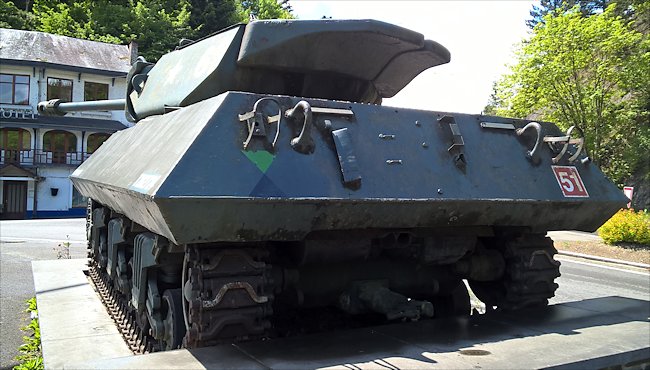
The M10 Achilles MkII 17pdr Tank Destroyer needed to have counter weights at the rear of the turret to stabilise the large gun
The hull and running gear were taken from the Sherman tank design. The power for the tank came from two Chrysler 2 stroke diesel engines, that each weigh over a tonne, at the back of the vehicle which drove a gearbox at the front
Major V. A. Arnold was in charge of a battery of M10 Achilles TDs. He recorded in his war diary, a few days after D-Day in Normandy, "K troop destroyed two Tiger tanks, one Mark IV and a Reconnaissance vehicle. There casualties were one Sergeant and two gunners killed with four gunners wounded. One M10 burnt out. L troop destroyed three Tiger tanks and one Focke-Wulf FW190 plane. Casualties nil."
Major Albert Booth was also was in charge of a battery of M10 Achilles and landed on D-day. His regiment was immediately given a welcome by the Germans that he will always remember. "We lost six out of 12 on the first time we went into action. I can remember putting my head down that night and thinking, ‘My God if this is war then I can’t see myself living very long.’ I survived. On our first Tiger kill, rather interestingly the gun layer hit the tank right in the middle, on the side. It was a perfect shot. He waved his hat in the air and that was that."
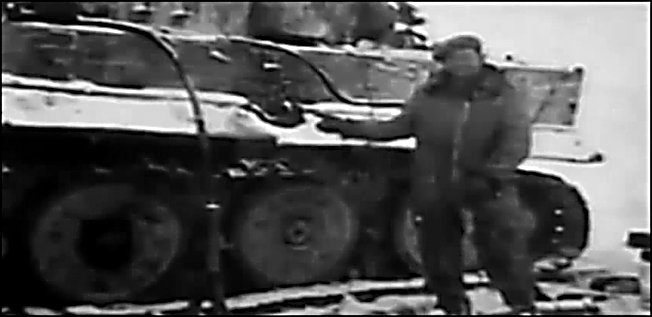
The poor quality photograph the Major still has in his possession is of that Tiger tank destruction. It shows the shell entered the left side of the tank’s hull just where the tracks slanted mud guard joins the hull, above the second from rear over lapping external wheel.
Ron Taylor was a radio operator in a British M10 Achilles bound for the Normandy beaches. He did not know where he was going until the last minute. He did not get told until they were at sea. Ron’s 17pdr Achilles stormed up the Normandy beach on D-Day+1. It was immediacy put into use, advancing with the troops, providing cover and knocking out enemy machine gun strong points.
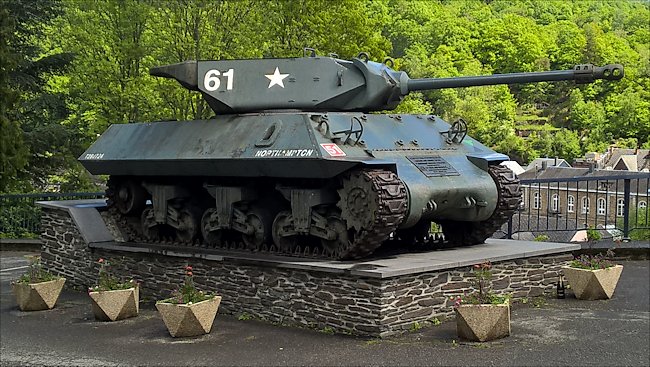
The British M10c Achilles MkII 17pdr Tank Destroyer only had thin armour on the side to keep the total weight down.
Ron recalls, "We did not drive into action like a tank would do. We were a defensive weapon. So we more or less followed up the attacking troops and served as back up if they were forced to retire. We dealt with counter attacks. Although the M10 may look like a tank it was just a well-armed field gun on tracks designed mainly to ambush advancing enemy armour.
"Unlike a tank we had to hand crank our turret ring so it took a long time to position the gun. It was not something you could flash around and fire indiscriminately. We were always told to aim at the enemy’s turret ring, if possible its rear, its tracks and bogies. If a Tiger was coming head on you had no chance even with the 17pdr."
"We used the ammunition catching canvas bag on the 5.0 Browning machine gun for keeping the army biscuits. We would also crush the bag with the biscuits in it under the tracks and then make porridge with the crumbs. For D-day we had to waterproof every seam and put a canvas screen around the gun and gun mantle "
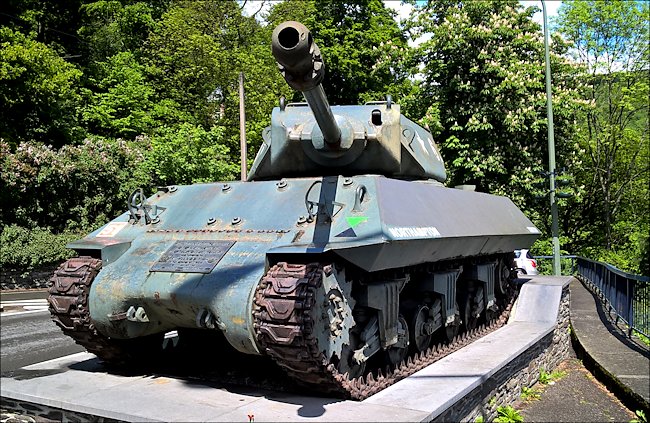
The M10c Achilles MkII 17pdr Tank Destroyer gun had a muzzle brake to reduce recoil and extend the life of the gun barrel.
Around 400 Achilles poured onto the Normandy coast on D-Day. They were fitted with two very large temporary rectangular exhausts to stop the seawater pouring into the engine. This wading gear was removed once on dry land by the gunner just swinging the turret 360 degrees and the gun knocked them off.
The extended wading exhaust ducts were only designed to get the tank destroyer on to the beach. If they stayed on any longer they would have cause the engines to overheat. MG, the car maker was used to produce tank wading gear. It produced 3,000 units in just a few weeks.
The outside of the tank was painted olive drab but the inside of the tank destroyer’s chassis was painted bright white to maximise the light inside. The inside of the open turret was painted olive drab as well.
What is the difference between the MkI and MkII Achilles?
The American's fitted three different types of rear turret counter weights on their M10 Wolverines. The earliest was simple plates of steel. When the turret rear was redesigned a triangular counterweight was added to the back of the turret. Later the large dolphin tail style rear turret counter weight was added to give more stability. M10s fitted with the first ones were replaced and upgraded on U.S. M10 Wolverines in service, in early 1943O.The original flat plate counter weights were cut off and replaced with the triangular type. Only the second and third type of counterweights were used on the British M10c Achilles. They were designated M10c Mk1 and M10c MkII but no-one really used official designations except in the rare occasion it effected the requirement for spares.
WW2 tank books

